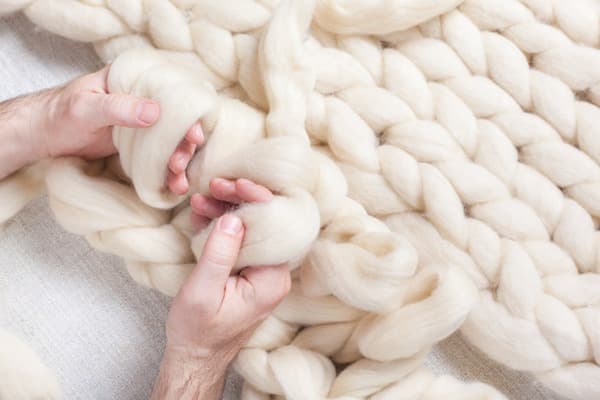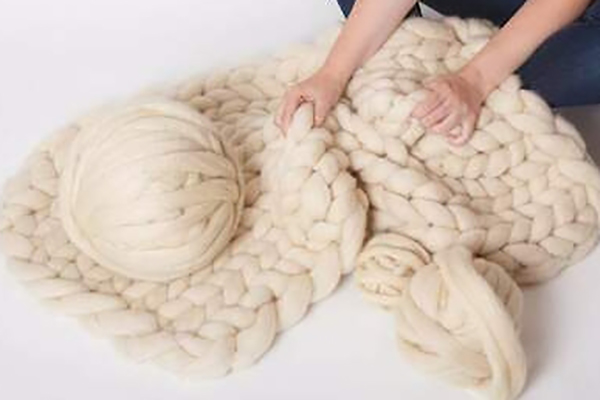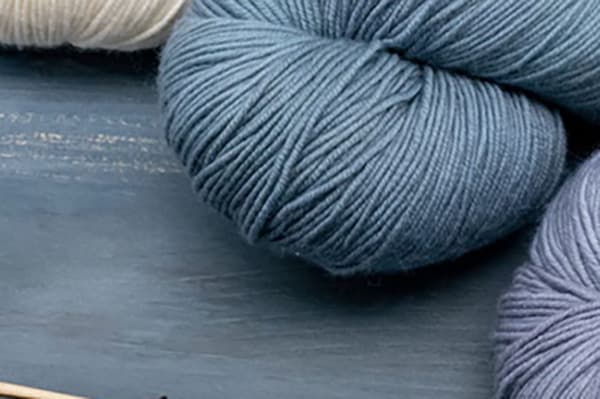Have you ever found the perfect knitting pattern, only to realize you don’t have the specific bulky weight yarn it calls for? Or perhaps you have a large stash of thinner yarn you’d love to transform into a cozy, chunky blanket. As a manufacturer and supplier in the textile industry for decades, I’m Allen, and I can tell you there’s a simple, brilliant technique that unlocks a world of creative possibilities: holding two or more strands of yarn together. This guide will walk you through everything you need to know about this method, from calculating the new yarn weight to managing your skeins. It’s a game-changer for everyone from large-scale textile factories to individual crafters, allowing you to create custom fabrics, substitute yarn weights with confidence, and make the most of the yarn you already have.
Why Would You Knit or Crochet with Two Strands of Yarn Together?
Working with multiple strands of yarn at once is a technique used for both practical and artistic reasons. For procurement officers like Mark Thompson, who I often speak with at exhibitions, this method can be a creative solution to supply chain challenges. If a specific bulky yarn is unavailable, a factory can combine two strands of a more readily available worsted weight yarn to keep production lines moving. This doubling technique is incredibly versatile.
The primary reason is to create a heavier weight yarn. By holding two strands of a lighter yarn together, you effectively make a new, thicker strand that works up faster and creates a denser, warmer fabric. Beyond simple substitution, this method allows for immense creativity. You can combine different colors of yarn to produce a "marled" or "heathered" effect, resulting in a fabric with beautiful depth and visual texture that you can’t buy off the shelf. This is a fantastic way to create a truly unique garment or textile product. It’s also a wonderfully economical way to use up leftover skeins or that single ball of yarn in your stash that isn’t enough for a project on its own. Combining it with another yarn gives it a new life. This is a common practice for both industrial knitting and hand crochet projects.

How Does Doubling Up on Yarn Affect the Final Weight?
When you hold two strands of yarn together, you are essentially creating a new, thicker ply yarn. The resulting yarn weight is significantly heavier than a single strand of the original yarn. Think of it this way: two strands of worsted weight yarn, when held together, will behave similarly to a bulky or chunky weight yarn. The final fabric will be denser, squishier, and have less drape than a fabric knit from a single strand of the same yarn on larger needles.
This change in density and structure is a key factor. The two strands of yarn will twist around each other slightly as you knit or crochet, which adds strength and body to the finished item. However, it’s important to remember that this new yarn is not identical to a commercially spun bulky yarn. A purpose-spun bulky yarn is created by spinning multiple plies together into a single, balanced strand. A doubled yarn, on the other hand, consists of two separate strands working in parallel. This can sometimes affect stitch definition and the overall feel of the fabric, which is why swatching is absolutely essential to see if you like the result before committing to a large project. The yarn behaves differently, and understanding that is key to success.
What is the Formula for Combining Yarn Weights?
While there’s no single, perfect mathematical formula that works for every type of yarn and fibre, there is a very reliable rule of thumb that serves as an excellent starting point. This chart is a go-to resource for crafters and textile designers looking to experiment with doubling yarn.
| If You Hold 2 Strands Of This… | You Will Get Roughly This… |
|---|---|
| Laceweight Yarn | Fingering Weight Yarn |
| Fingering Weight Yarn | Sport/DK Weight Yarn |
| Sport Weight Yarn | Worsted/Aran Weight Yarn |
| DK Weight Yarn | Aran/Bulky Weight Yarn |
| Worsted Weight Yarn | Bulky/Chunky Weight Yarn |
| Bulky Weight Yarn | Super Bulky/Jumbo Yarn |
A more technical approach is using "Wraps Per Inch" (WPI). To do this, you wrap your yarn around a ruler for one inch, without stretching or squishing the strands. Count the number of wraps.
- Formula: WPI of single
strand/ 2 = Approximate WPI of doubledstrand. - Example: If your worsted
yarnis 9 WPI, two strands held together will be approximately 4.5 WPI, which falls squarely in the bulkyyarn weightcategory.
Remember, these are guidelines. Factors like the fibre content (cotton vs. merino wool) and how the yarn is spun (a smooth ply vs. a lofty rove) will influence the final gauge. There is no substitute for creating a swatch to confirm your yarn weight and fabric characteristics. A good swatch will tell you everything you need to know.
Can I Substitute Bulky Yarn by Doubling a Lighter Weight Skein?
Absolutely! This is one of the most common and practical applications of the doubling technique. Let’s say a pattern calls for a bulky yarn and you have a large quantity of a beautiful worsted weight yarn. By holding two strands of your worsted yarn together, you can very likely meet the pattern’s gauge requirements. We see our customers, who are often large manufacturers, do this when a specific bulky yarn isn’t in stock or when they want to create a custom color blend.
To do this successfully, follow these steps:
- Check the Chart: Use the chart above to confirm your intended substitution makes sense (e.g., 2 strands of worsted ≈ 1
strandof bulky). - Calculate Yardage: Ensure you have enough
yarn. You will need the pattern’s total required yardage for each of the two strands. (More on this below). - Make a Gauge Swatch: This is the most critical step. Using the needle size recommended in the pattern, create a 4×4 inch
swatchwith your two strands held together. Block it as you would the final garment. - Measure Your Gauge: Does your stitch and row count
per inchmatch what the pattern calls for? If you have too many stitches, go up aneedlesize. If you have too few, go down aneedlesize. Makingswatchesis key.
This substitution method empowers you to use the yarn you love, even if it’s not the exact weight specified. It’s a trick that can save a project.
How Do You Calculate Yardage When Doubling Yarn?
This is a point that often trips people up, but the math is quite simple. When you are holding two strands of yarn together, you are using both strands at the same rate.
The Rule: If your pattern requires X yards of a heavier weight yarn, you will need X yards of EACH strand you are holding together.
Let’s break it down with an example:
- A pattern for a chunky sweater calls for 800 yards of
bulky yarn. - You decide to substitute by holding two strands of
worsted weight yarntogether. - You will need 800 yards of the first
strandof worstedyarn. - You will also need 800 yards of the second
strandof worstedyarn. - Total worsted yarn needed: 1600 yards.
If a skein of your worsted yarn contains 200 yards, you would need 8 skeins in total (4 for the first strand, and 4 for the second). It’s always wise to buy a little extra yarn just in case, as your mileage may vary slightly. A typical 100g skein of worsted yarn often has around 200-220 yards.
What Needle or Hook Size Should I Use for Doubled Yarn?
When you’re working with a doubled strand of yarn, you should not use the needle or hook size recommended for the original single strand. Instead, you should start with the needle size recommended for the target yarn weight you are trying to create.
For instance, if you are holding two strands of worsted yarn together to create a bulky weight yarn, you should look at your pattern or a standard yarn weight chart to see what needle size is typically recommended for bulky yarn (usually around 6.0mm – 8.0mm or US 10-11). Use that as your starting point for your gauge swatch.
Expert Tip from Allen: "In our manufacturing facilities, when we test a new textile construction using doubled
yarn, we always produce severalswatcheson differentneedlesizes. The goal isn’t just to match agauge, but to see how the fabric behaves. Does it have the right drape? Is the stitch definition clear? Swatching isn’t just about size; it’s about creating the right fabric."
The final needle or hook size will be determined entirely by your swatching results. Don’t be afraid to experiment. A small change in needle size can make a big difference in the final look and feel of your project. The right needles to use are the ones that give you the fabric you want to create.

What Are the Best Tips for Managing Your Yarn Skein When Working with Multiple Strands?
Working with two or more strands of yarn at once can sometimes lead to a tangled mess if you’re not prepared. As a supplier of everything from fine polyester yarn to robust fishing line, we know a thing or two about preventing tangles. Here are the two best methods for managing your yarn:
-
Method 1: Two Separate Balls of Yarn
This is the most straightforward approach. You simply take two separate skeins or balls ofyarnand pull onestrandfrom each. To keep them from rolling around and tangling, place them in separate yarn bowls or even just two different project bags on either side of you. This is the best method if you are usingmultiple balls of yarnof different colors to create a marled effect. It keeps everything neat and tidy. -
Method 2: The Center-Pull Ball
If you haveone skein of yarnthat is wound into a center-pull ball (where you can pull astrandfrom the inside and astrandfrom the outside), you can use both ends of the same ball. This is a clever trick that means you only have oneskeinto manage.- Pro: Very compact and portable.
- Con: The
yarncan sometimes twist around itself and create tangles as the ball gets smaller. This is sometimes called "yarn barf." It requires a bit more attention, but many people prefer it.
No matter which method you choose, the key is to let the yarn untwist naturally every few rows. Just let your project dangle and spin to release any built-up tension in the strands of yarn together.
Can You Mix Different Types of Yarn When Doubling?
Yes, and this is where the magic really happens! Mixing different yarn fibers and textures is a fantastic way to create a completely custom fabric. The possibilities are endless. For example, holding a smooth merino woollen yarn with a fluffy, laceweight mohair-silk blend yarn creates a fabric with a beautiful "halo" and a soft, luxurious feel. The mohair strand adds texture and warmth without adding much weight.
Here are a few things to keep in mind when mixing different types of yarn:
- Fiber Content: Remember that your final item will have the care requirements of its most delicate
fibre. If you mix a machine-washableyarnlike our 100% spun polyester yarn raw white in hanks with a hand-wash-only woolyarn, the entire garment must be hand-washed. - Elasticity: Different fibers have different amounts of stretch. A stretchy merino
yarnheld with a non-stretchy cottonyarnwill create a fabric with less memory and elasticity than the merino alone. This can be a design feature! - Color: Holding two slightly different shades of the same color can add incredible depth. Combining a solid color
yarnwith a variegated or speckledyarncan tone down the wilder colors and create a more cohesive look. This is a technique we often recommend to designers trying to create a specific textile appearance. Theyarncombination is what makes the project unique.

Does This Technique Work for Amigurumi and Other Crochet Projects?
The doubling yarn technique is absolutely fantastic for crochet and is particularly well-suited for amigurumi. When making amigurumi, the goal is typically to create a very dense, stiff fabric so that the stuffing doesn’t show through the stitches. By holding two strands of a thinner yarn together (like a sport or DK weight yarn), you can use a smaller-than-usual hook to create an incredibly tight and firm fabric.
For other crochet projects like baskets, bags, or rugs, using two strands together adds structure and durability. A basket crocheted with two strands of sturdy cotton yarn will stand up on its own much better than one made with a single strand. For blankets and garments, doubling the yarn allows you to create a chunky look and feel, and the project will work up much more quickly. It’s a versatile tool for any crochet enthusiast looking to control the final properties of their project. Many crochet patterns are now being designed specifically for doubled strands of yarn.
What Are the Potential Downsides of Doubling Yarn Strands?
While holding multiple strands of yarn is an amazing technique, it’s good to be aware of a few potential challenges. Being prepared for them will ensure a smooth and enjoyable crafting experience.
- Tangles: As mentioned, managing two
strandscan lead to tangles if you’re not careful. Using yarn bowls or the center-pull method can mitigate this. - Tension Issues: It can sometimes be tricky to make sure you are holding both
strandswith the same tension. If onestrandis looser than the other, you may see small loops on the surface of your fabric. Practice and mindfulness are key. - Splitting Plies: You have twice as many
plylayers to manage, so it’s easier to accidentally split onestrandwith yourneedleor hook, especially with a splittytype of yarn. Working in good light can help you see yourstitchclearly. - Fabric Density: A fabric made with two
strandsis often heavier and denser than a fabric made with a commercially spunyarnof the equivalentweight. It may have less drape. This can be a positive for a sturdy bag, but might not be what youreally want to makefor a flowy shawl. Once again, yourgauge swatchis your best friend—it will tell you exactly how the fabric will behave. Apattern that callsfor a lot of drape might not be the best candidate for this substitution.
Key Takeaways
Mastering the art of working with a double strand of yarn is a skill that dramatically expands your creative freedom. It’s a technique we use in industrial settings and one that every home crafter should have in their toolkit.
- Create Heavier Yarn: The primary reason to hold two strands together is to create a thicker,
heavier weight yarnfrom lighterweightyarns. - Formula is a Guideline: Use the rule of thumb (2x Worsted ≈ 1x Bulky) as a starting point, but always rely on a
gauge swatchfor true accuracy. - Yardage Doubles: Remember to have enough
yarn! If a pattern needs 500 yards ofbulky yarn, you need 500 yards of each of your two lighter strands. - Manage Your Skeins: Use two separate balls or the center-pull method from a single
skeinto prevent tangles. - Mix and Match: Don’t be afraid to combine different colors and fibers to create unique, custom fabrics.
- Swatch, Swatch, Swatch: It is the only way to know for sure how your chosen
yarncombination will behave in terms ofgauge, drape, and texture.





